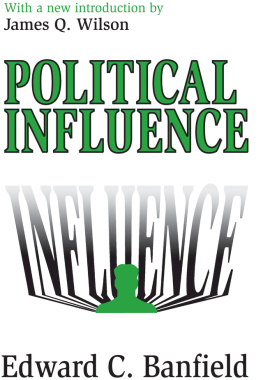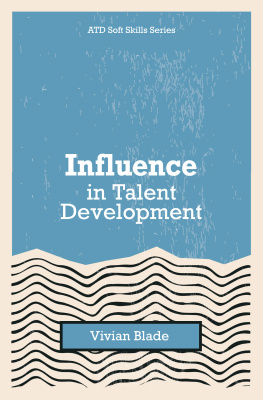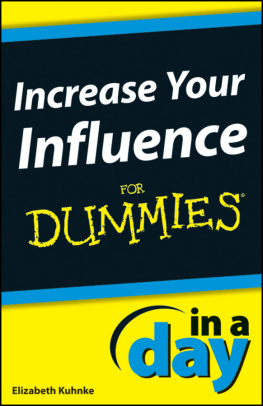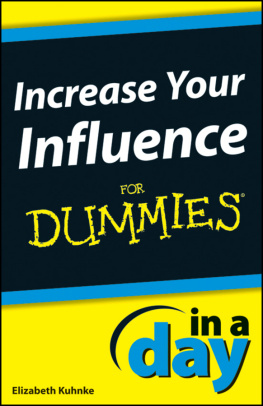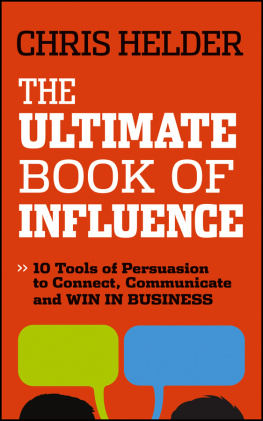Originally published in 1961 by The Free Press of Glencoe
Published 2003 by Transaction Publishers
Published 2017 by Routledge
2 Park Square, Milton Park, Abingdon, Oxon OX14 4RN
711 Third Avenue, New York, NY 10017, USA
Routledge is an imprint of the Taylor & Francis Group, an informa business
Copyright 2003 by Taylor & Francis.
All rights reserved. No part of this book may be reprinted or reproduced or utilised in any form or by any electronic, mechanical, or other means, now known or hereafter invented, including photocopying and recording, or in any information storage or retrieval system, without permission in writing from the publishers.
Notice:
Product or corporate names may be trademarks or registered trademarks, and are used only for identification and explanation without intent to infringe.
Library of Congress Catalog Number: 2003060203
Library of Congress Cataloging-in-Publication Data
Banfield, Edward C.
Political influence / Edward C. Banfield; with a new introduction by James
Q. Wilson.
p. cm.
Originally published: Glencoe, III.: Free Press, 1961.
Includes bibliographical references and index.
ISBN 0-7658-0556-1 (alk. paper)
1. Chicago (III.)-Politics and government-1951-Case studies.
2. Pressure groups-Illinois-Chicago-Case studies. I. Title.
JS708.B2 2003
320.9773'11'09045--dc22
2003060203
ISBN 13: 978-0-7658-0556-0 (pbk)
Those who were privileged to know Edward Banfield can only with some difficulty convey to others his true greatness. If you neither knew nor read him, he is unknown to you, for he had no interest in fame or publicity. On one occasion, the publishers of Who's Who announced that he would be included in their next edition. He wrote back to say that he did not want to be included; if they printed a sketch of him despite his objections, he would sue them. Had he thought that his writings would bring him fame, he would no doubt have molded his bold arguments to fit the temper of the times, and so never would have suggested that political machines are useful, that most urban problems are spurious and the few that exist cannot be solved by any popular remedy, and that art museums should display perfect copies of their paintings and sell the originals to people foolish enough to think they can tell the difference.
If you read his books but did not know the author, you might well be intrigued, but since you would be surrounded by people who believe that the opposites of these claims are true, you would be left alone to defend heresy against orthodoxy, no easy task. But if you knew Banfield you would have understood first-hand why his great intellect and coherent arguments stood so powerfully against much of elite opinion. You would have understood, in short, why this man of common origins and an uncommon mind tested the conventional opinions of intellectual elites against the practical needs of ordinary people.
Prophet without Honor
In time, much of what Banfield wrote was accepted by bright people as, slowly and unevenly, they were mugged by reality. In 1955, he and Martin Meyerson published a book about Chicago public housing projects, explaining why these tall, grim buildings, located in areas that guaranteed racial segregation, were a serious mistake. At the time this was a powerful dissent from the view that housing projects must be built and that alternativessuch as supplying vouchers to those who needed financial help in renting housingwere unthinkable. Today, vouchers are intellectually respectable, and some housing projects are being dynamited to remove these eyesores from their cities.
In 1958, Banfield, with the assistance of his wife, Laura, published The Moral Basis of a Backward Society, in which they explained why a region in southern Italy was poor. The reason, they said, was not government neglect or poor education, but culture. People in this area were reluctant to cooperate outside of their families. This kind of "amoral familism," as they called it, was the result of a high death rate, a defective system of owning land, and the absence of extended families. By contrast, in an equally forbidding part of southern Utah, the residents were engaged in a variety of associations, each busily involved in improving the life of the community. In southern Italy, people did not cooperate; in southern Utah, they scarcely did anything else.
Foreign-aid programs, Banfield later wrote, ignored these profound cultural realities and instead went about persuading other nations to accept large grants to build new development projects. Few of these projects led to sustained economic growth; indeed, the grant money was often stolen by local political elites. As P. T. Bauer later put it, foreign aid was a policy whereby poor people in rich countries had their money sent to rich people in poor countries. Where rapid economic growth did occur, as in Hong Kong, Singapore, and South Korea, foreign aid, to the extent it existed at all, made little difference. Today, scholars recognize the great importance of culture in explaining why some areas of the world are poor and others prosperous. Few of them, however, refer to Banfield's writings. One recent exception is Culture Matters, edited by Samuel P. Huntington and Lawrence Harrison, which was dedicated to Banfield.
In 1970, Banfleld published his most famous book, The Unheavenly City, in which he argued that the "urban crisis" was misunderstood. Many aspects of the so-called crisis, such as urban residents' flight to the suburbs, were not really problems at all, he argued, but instead great improvements in human lives. True problems such as crime, poverty, and racial injustice continued to exist because we do not know how to end them.
Take the problem of poor African Americans. Racism, though much diminished in recent years, still exists and has a significant effect. But the central difficulty for many black Americans is not racism but poverty, and a large part (though far from all) of that poverty, Banfield argued, arises from a lower-class culture. By this he meant a culture that reflects a short time-horizon, in which life consists in living from moment to moment. To the extent people in such a culture think about the future, they feel it is largely shaped by fate, not by their own activities. They are interested in present action, and among males, in risk-taking, fighting, and respect. The last quality is especially important to people who have trouble making friends and who resent any sign of authority. A lower-class culture is often the product of female-headed households where women have a series of lovers, none of whom takes much responsibility for raising the children that result from casual encounters. This is a problem for all lower-class people, white or black, but for blacks it acquires a special edge because "much of what appears...as race prejudice is really class prejudice." Banfield predicted that his book would "probably strike many readers as the work of an ill-tempered and mean-spirited fellow," and he was absolutely right. Academic denunciations were hurled down on him; he was called, among other things, a reactionary and a racist. Within twenty years, however, books were appearing that, without mentioning Banfield, discussed how social class had shaped inner-city life for African Americans. In 1987, William Julius Wilson wrote in his widely acclaimed book The Truly Disadvantaged that though racism exists, social class could explain the plight of many blacks. To Wilson, an "underclass" existed because of the absence of inner-city jobs. Banfield would have agreed, up to a point, but he would have argued that there are also independent cultural factors at work.

